Italy by Motorhome
Please note: this is an archived post. For the latest information please see our post about how to tour Italy in a motorhome.
Published in August 2012.
The below guide has been written based on our experiences touring Italy by motorhome and will hopefully give you a good idea of what it’s like to travel there. However, things do change, so before you set off it’s worth checking for up to date travel information from the Foreign Office website, and the latest driving regulations on the AA website. At the bottom of the guide we’ve added links to our daily updates while we were in Italy, so you can live the adventure with us.
General Information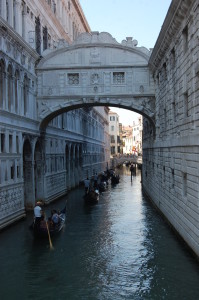
Country – Italy
Capital city – Rome, 1070 miles from Dover
Currency – Euro
Languages – Italian
Visa requirements – Part of the EU so visas not required for EU citizens.
Borders – Part of Schengen zone. No border formalities with other Schengen zone countries, such as France, Austria and Slovenia. At border with Switzerland we had a very short queue before being waved through without showing our passports, but have them ready just in case.
Telephone country code – 39
Emergency numbers – 112 EU wide hotline, 113 Police, 115 Fire, 118 Ambulance
Our visits
March 2013 – April 2013 (South Coast)
Duration – 13 days
Route – From Villa San Giovanni where the ferry from Sicily landed, we headed north then took a motorway which cut across to the south coast. We followed the coast all the way along the ‘sole of the foot’. We nipped inland to Matera then went south and followed the coast around the heel to Bari where we caught the ferry to Greece.
Miles driven – 1211
Average daily spend – €44.74
Average spend on overnight stops – €0.23 (13 free nights – 0 free aires, 13 free camping, one charge of €3 to use a service point)
December 2012, January 2013 & March 2013 (Sicily)
Duration – 39 days
Route – Travelled clockwise around the island (with a detour up Mount Etna) to Gala, then went across the island to Palermo. Caught ferry to Tunisia from Palermo returning six weeks later. We then went anti-clockwise around the coast to Agrigento before crossing inland to Catania and up the coast to Messina
Miles driven – 1726
Average daily spend – €40.82
Average spend on overnight stops – €2.90 (27 free nights – 0 free aires, 27 free camping, 12 paid nights – 4 paid aires, 8 campsite)
November 2012 – December 2013 (Italian West Coast & Tuscany)
Duration – 57 days
Route – Crossed from Switzerland near Brig then travelled south along the east coast, nipping inland around Tuscany and Rome.
Miles driven – 2680
Average daily spend – €34.59
Average spend on overnight stops – €4.54 (36 free nights – 14 free aires, 22 free camping, 21 paid nights – 11 paid aires, 10 campsite)
May 2012 (Northern Italy)
Duration – 22 days
Route – Crossed border from France near Borgo San Dalmazzo then travelled east through Cheraso, Alba and Asti. We then headed north east towards Lago d’Orta, north round Lago Maggiore and into Switzerland for a couple of days on a campsite (and cheap fuel). East to Lago d’Iseo then round Lago Garda and onto Verona. North into the Dolomites to watch the Giro d’Italia on Passo Giau, then south to Treviso and Venice before heading north to Udine and Tarvisio before crossing into Austria (via Slovenia for more cheap fuel).
Miles driven – 927
Average daily spend – €28.45
Average spend on overnight stops – €3.64 (16 free nights – 8 free aires, 8 free camping, 5 paid nights – 4 paid aires, 2 campsite)
Costs
Diesel
We found the prices at the petrol stations to be very confusing at first, often each pump had its own set of prices as you pay less for filling up yourself. The prices on the entrance board are often the cheaper of the two prices and already include the discount mentioned for self service. We found diesel to be much more expensive in Italy than any of it’s neighbouring countries. When were near a border we nipped across and filled up with fuel (Slovenia €1.31, Switzerland €1.59). In Italy it varied between €1.63 and €1.74 and didn’t seem to get any cheaper in the south or Sicily. We did notice that the prices changed throughout the day and appeared to be cheaper at the weekends.
LPG
LPG was widely available and priced between €0.82 – €0.86 per litre. It was a bit more expensive on Sicily (€0.88 – €0.92). It is available at some petrol stations, but also at dedicated Auto Gas stations.
Eating out
We found eating out to be fairly expensive in Italy, so we mainly had snacks (ice cream) when out and main meals in our motorhome. But being the home of great good, we did eat out a few times just to see what all the fuss is about. In cafes you pay more to sit down and drink, if you want it cheaper stand up at at the bar with the locals. Keep your eyes peeled for food vans, they seem to be permanent fixtures in car parks and open up at night cooking up fresh tasty meat sandwiches, they are also often busy until the early hours.
Ice creams in Italy are some of the most expensive we’ve come across, but also the best! Food prices in restaurants and cafes did seem to go down as we got further south and on Sicily, or maybe we got more savvy at picking out local eating places instead of tourist ones?
- 2 x large orange spritzer drinks, looked a bit like Irn Brew €8.00
- 2 x hand sized pasties from take away in Verona €6.00
- 1 coffee, 1 hot chocolate at cafe at top of Passo Giau in Dolomites €3.75
- Ice creams (cone and one scoop) €1.30 – €2.00 (in Rome €3.25)
- Takeaway Roast Chicken from mobile van €7.00
- 2 x main courses with glass of wine – €27.50
- 1 x expresso Palermo cafe €1.00
- 2 x filled rolls, 2 x soft drinks, 2 x cakes in Venice – €20.00
- 2 x huge takeaway pizza slices in Lucca €5.00
- 1 x large portion of chips at market €3.20
- 2 x Tourist Menu lunch 2 courses with 0.5l wine €30.00
Supermarkets – supermarkets used Lidl, Billa, E.Leclrec, Carrefour, MD Discount, Sidis (Lidl would not accept either our Visa or Mastercard so we adopted a policy of always paying in cash at all supermarkets, just in case!).
In bakeries bread is prices by the kilo instead of per item and you can ask for half or part of a loaf. We love the machines in some car parks where you fill your own bottle (you can buy one in a vending machine next to the machine and reuse it) with either; fresh cold milk for between €0.85 – €1 or still or sparkling water for 10c – 15c a litre. To keep costs down we also refilled our water bottles from the numerous drinking fountains in towns and cities – we weren’t the only ones!
- 1l UHT milk €0.59
- Baguette €0.56
- 250g mushrooms €1.69
- 125g mozzarella ball €0.59
- 1.5l still bottled water €0.19
- 500ml cheapest larger €0.48
- 1l carton of cheapest wine €0.85
- 4 x chocolate mouse €0.89
- 100g budget chocolate bar €0.55
Travel
Fuel
Unleaded and diesel widely available, the prices displayed can be confusing though – see the diesel section above. LPG (GPL) is reasonably well available, but only from manned service stations. When filling with LPG you will need the same dish type adapter as used in France. Many service stations away from the motorways close on Sundays, some have automated pumps so you can get fuel, but not LPG.
Tolls / Vignette
No vignette required. Most Italian motorways are toll roads as are several tunnels through the mountains – often owned by a private company. You collect a ticket at the machine as you enter the road and pay a person or machine at the end in cash or on a card.
There are usually several decent roads running parallel to the toll roads which in some cases are pretty decent dual carriageways. Be aware the in Italy motorways signs are green and other main roads blue – the opposite way round to most of Europe and the UK. We only used the toll roads a few times; once by mistake (we followed the green signs!) from Alba to Asti which cost €2.40, the rest were to keep out of congested areas around Genova and Naples. Motorways in the south are often free.
Road regulations – the ones we know of!
Traffic drives on the right and overtakes on the left, so you need to ensure your headlights are deflected either with stick on adapters or duct tape. You must carry a high visibility jacket for each person and a warning triangle for the vehicle. The jackets must be accessible to you before you get out of your car/motorhome, so don’t put them in your boot or garage. If you have to stop for any reason on the motorway, put it on before you get out. Dipped headlights are required outside of urban areas and nothing can stick out either side of your car/motorhome – so take care how you mount bicycles on racks. If you have a bike rack you’ll need a white and red stripped warning sign hanging from it – in Italy it is supposed to be made of aluminium, we used our plastic one we bought for Spain and had no problems.
There are rules around who has priority on the road, but in reality it can be a bit of a free for all. Sometimes drivers entering the roundabout have priority, often we weren’t entirely sure so we just took our time and gave way to anyone who looked like they weren’t stopping. Traffic going uphill is supposed to have priority over that going downhill in mountain areas.
Distances are all in kilometres, and so are speed limited. As you pass the name sign for a town the urban speed limit of 50kph applies, unless otherwise stated, until you leave the town. Signs stating ZTL mark out low emission zones, these have varying rules but basically they are to keep traffic out of areas either all the time or at peak times. We saw many of these in the cities and made sure we avoided them – especially those which are monitored by cameras!
Road conditions
The roads across the north of Italy are of a similar standard to the UK, if not slightly better in some places. The lakes we drove around posed no problems with overhanging rocks – however we have heard it is a problem on one of the lakes in one direction. Some of the tunnels around the lakes were dark and narrow.
As you got further south in the country the road (basically anything below Rome) conditions deteriorated, when we reached the ‘foot’ of the country Dave’s suspension was being fully tested all of the time and the sides of the roads were so overgrown they looked like an apocalyptic film set, even on the motorways.
Sicily was in a very similar condition, plus with the added bonus of bags of litter overflowing from the bins. The main area to be careful of is the cities, here roads can get amazingly narrow and our sat nav would happily try to send us down some of the narrowest – we made a rule that if there isn’t a sign to our destination we would ignore her instructions, that helped a lot.
Standard of driving
For a country where the way of life is slow and relaxed, bureaucracy takes months and projects never seem to move, put an Italian behind a wheel or on a motorbike and they are driving for Ferrari! Italian drivers are very confident, especially confident that they will pass you before the car coming in the opposite direction will reach them. They seemed reckless and impatient, turning two lane roads into three lane roads and forcing others out of the way. Solid white lines are routinely ignored, even double white lines are often crossed on blind corners. Like most drivers on the Continent, they will sit on your bumper waiting to over take. Jay worked out that in built up areas everyone is out to get in front of you no matter what – we would often let people pass us rather than have them perform some wild undertaking manoeuvre on a roundabout.
Horns are used far more frequently in Italy than anywhere else we’ve been. People will honk for everything from hello and I’m waiting outside your house, to I’m coming through/around this corner and get out of my way, you’re blocking the road, you’re driving too slow etc. You name it, they honk for it. If someone is coming towards you and flashing their lights, that usually means they are coming through (even on an overtake on their side) or you are deemed to be drifting onto their side of the road.
Parking is a big problem in Italian in the towns and cities, mainly because people do not want to walk and will happily double park using their hazard lights. Cars will also be found squeezed into a non-existent space by being parked at an angle and sticking out into the road – we had several occasions where I had to jump out and direct Jay through a tiny gap, one time we got completely stuck and the owner of a parked car had to be summoned from work to shift it.
All this said and done the traffic flows, it is almost organic and strangely a bit beautiful. Scooters weave in among the stationary cars and when you do get stuck or make an error, people will stop honking, after all they all make mistakes too.
Overnight stops
Aires/Service points
Italy is well geared up for motorhomes, but it is a country of two halves. Above Rome there are many sostas, the ones we visited were very well maintained, some even had free electricity.
Sosta is the Italian word for an Aire, somewhere that you can park your motorhome overnight and use the service point to fill up with water, empty grey water and empty black water. The prices vary greatly, expect to pay up to €20 for one in a heavy tourist attraction area such as Pisa, but there are also many towns with free parking, you just pay to use the services, and some even have free services. As Italy has a great public transport system and dogs are allowed on it for free, we would often park at a free/cheaper sosta a little way out of a city and catch the bus/train in.
Below Rome the Sosta’s dried up, but there was miles or free parking available at beaches and marinas. Sicily was the same with loads of free camping spots, we just nipped into campsites and paid to use their services.
Campsites
We’ve stopped in a few campsites (Punta Sabbioni near to Venice, Rome, Pompeii, Giardini Naxos in Sicily) and found they had great services for us. Many didn’t have swimming pools etc, or if they did they were closed as it was out of season. All were close to public transport which meant you could stop for a few days and explore the area. The campsite in Sicily was only €6 per night in the winter, so we stopped there for a few nights over Christmas and when we returned from Tunisia.
Free / wild camping
A tourist office in the Piedmont region told us that as long as we were legally parked, we were OK to stop in car parks. White lines denoted free parking places, blue lines meant you had to pay at a meter. We stopped in several car parks, the police even popped by in the one next to the market in Asti to check we were OK.
We also free camped in the Dolomites by the side of the road to watch the Giro d’Italia, but we suspect that was a special occasion and wouldn’t generally be allowed. In the south of the country and Sicily we free camped many times as we were there out of season and the beaches were deserted.
Contact with home
Phone
Our mobile phone always found a signal in Italy – call charges were around 30p to make and 10p to receive (per minute). Text messages are free to receive and around 10p to send.
Email/Internet
We struggled to find free wifi hot spots, even McDonalds was locked down so you couldn’t access their wifi without an Italian phone number. All the ones we could find were secured. So we bought a 3G SIM card for our dongle from a Vodafone store. No contract, prepaid and no need for a Italian credit card it also provided us with an Italian phone number but we never tried to use it to access McDonalds wifi. The SIM cost €20 (5gb over 30 days).
When we returned to Italy we tried to recharge our Vodafone SIM only to be told that it would be better to buy a new one as they can only be recharged in monthly increments – ours was bought on the 18th or the month so could only be recharged for a month on the 18th! We bought another one and used that. We had a problem with our Europa SIM as we weren’t aware that a different APN (Access Point Name) needed to be used in Italy, so we ended up paying double until we spotted that our money was running out fast and contacted them.
When we returned to Sicily from Tunisia we bought a SIM from 3, it was priced at €15 in the shop, but we when we came to pay we were charged €25 (the extra being the cost of the SIM and a charge on it that we didn’t want!), it only worked for two days. We went back to 3 and were told we needed to wait for an SMS on the third day before we logged on, this hadn’t been mentioned when we bought the SIM, and now all the data was gone. We’d advise you to take your time in the mobile shop and ensure you know the rules of your SIM when you buy as they seem to make it as complicated as possible!
Post
Post offices are called Poste. You can buy stamps (francobolli) from there or Tabacconists (Tabacchi) – recognisable by a maroon and yellow sign, we found it helps to wave postcards in the Tabacchi in rural areas as sometimes they don’t speak English and it gives them a clue as to what you want.
We tried to get some stuff sent Post Restante to us in Sicily, after an hour we gave up. Despite the post office website stating they offer the service in any post office, the one we were at flatly refused to believe it existed – lord knows where our parcel went! If you need things sending to you, get them delivered to a campsite.
Read our daily updates
At the bottom of each daily update there is a link to take you forward to the next day or back to the previous. The links below will take you to the first day of that part of our tour, so in this case you will also get our two days in Switzerland in the middle of our trip through Italy.
South Coast of Sicily – April 2013
Sicily – March 2013 – April 2013
Sicily – December 2012 – January 2013
Western Coast of Italy – November – December 2012
Northern Italy – May 2012

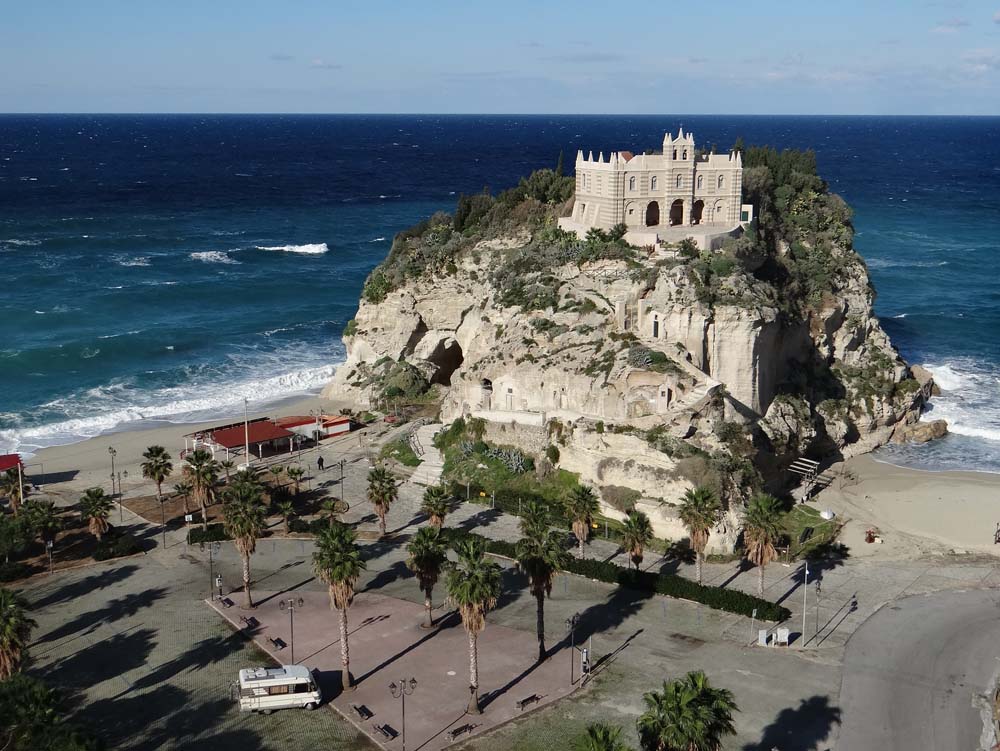
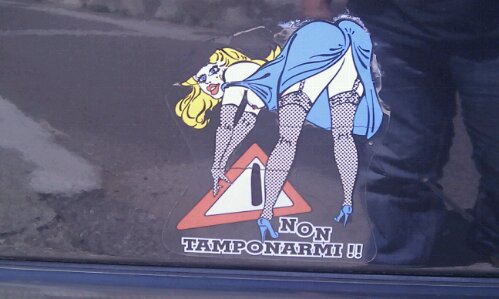
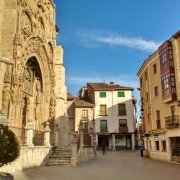
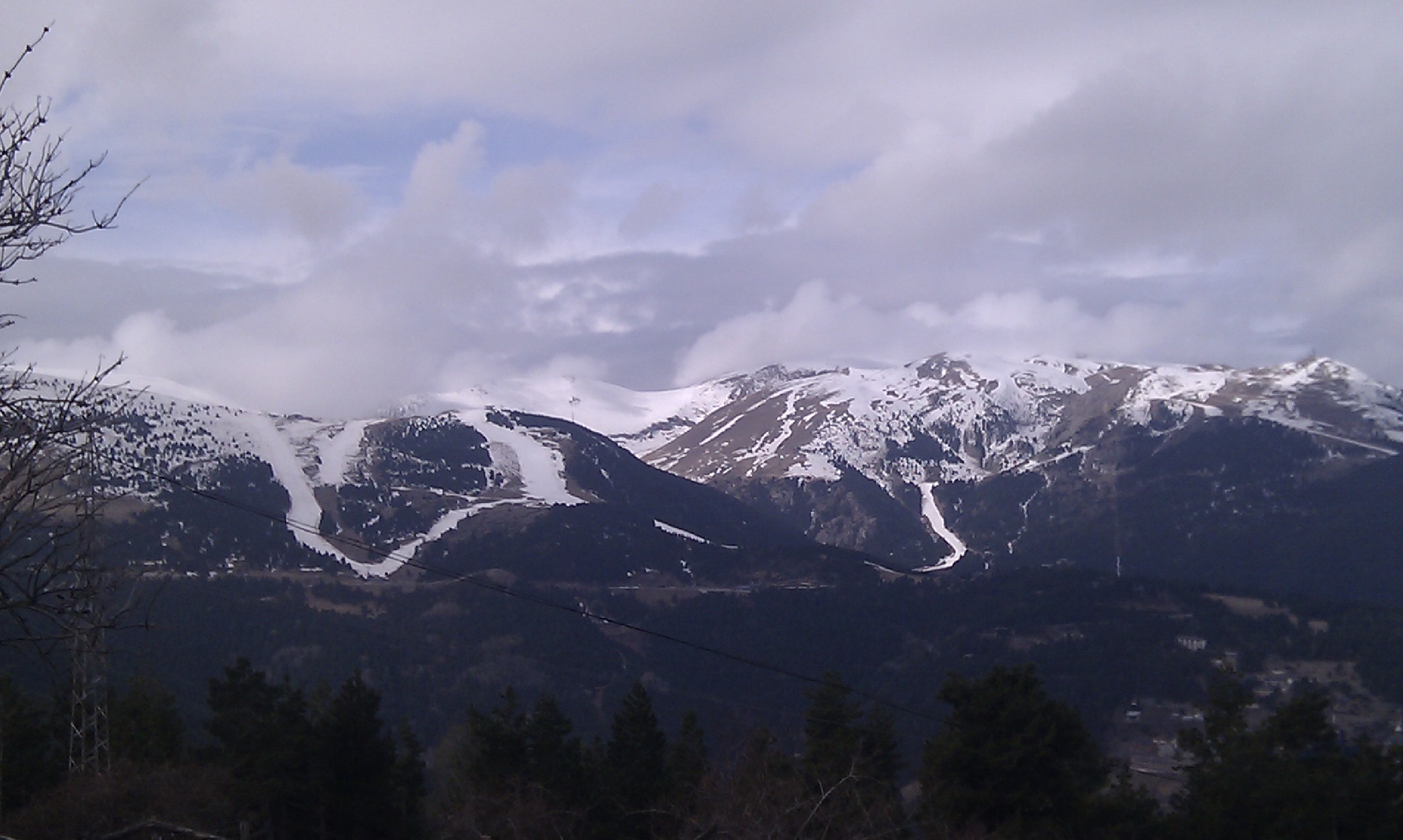
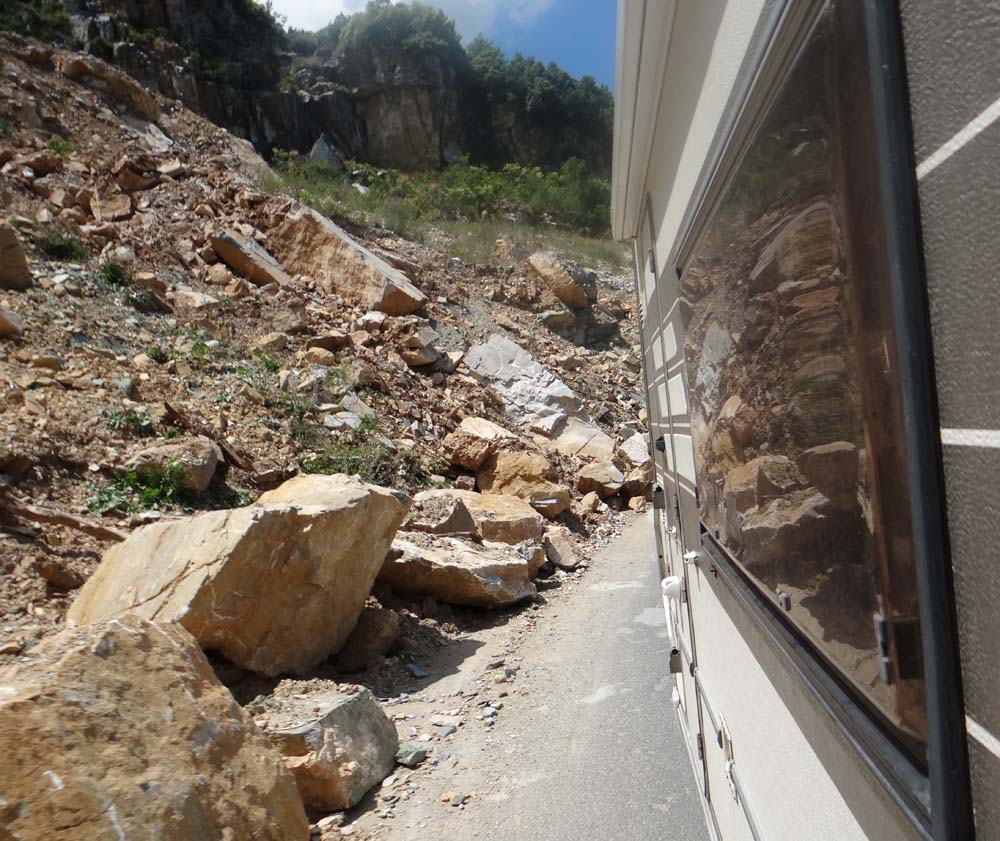
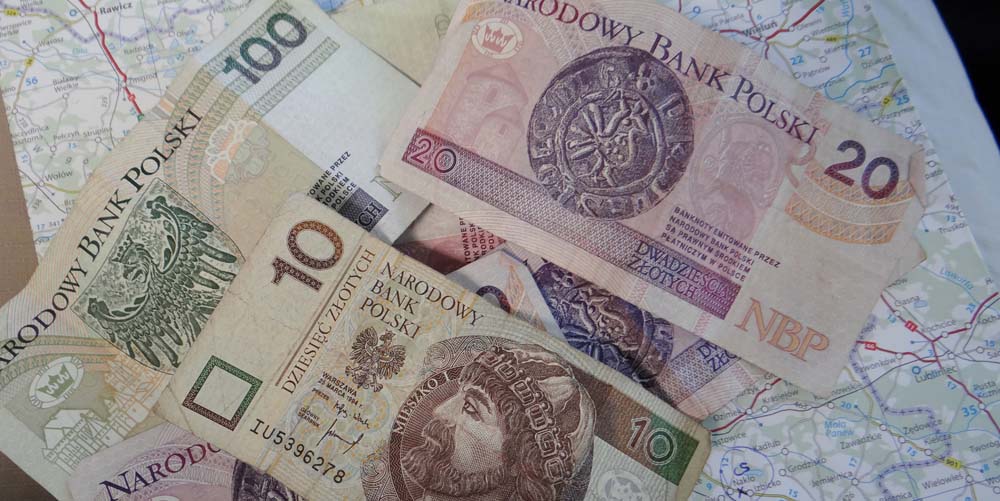

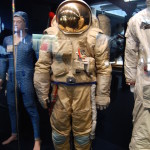

Another tour de force – or should that be another tour de Dave?
Grazie mille!
Best,
Simon
Hello. Did you stay anywhere near Lago Garda? Would love to find a free/cheap sosta if you know of any?!
Great blog by the way and thanks for all the great info!
Hi Jenna
We drove around Lago Garda and stopped on it’s shores for a couple of nights. There is an official sosta at the top end which charges 50c an hour, but that was a bit steep for us!
We would have slept in the official motorhome parking at Salo, but it was market day so we joined the other Italian motorhomes illegally parked in a nearby car park.
You can read all about our trip around the lake and gps of where we stopped in these two posts.
https://ourtour.co.uk/home/lake-garda-beautiful-italy-continues/
https://ourtour.co.uk/home/lake-garda-and-the-expensive-traffic-jam/
Cheers
Julie